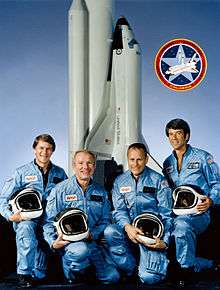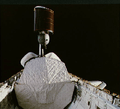STS-5
 The SBS 3 satellite with attached PAM-D motor is deployed from Columbia | |||||
| Mission type | Satellite deployment | ||||
|---|---|---|---|---|---|
| Operator | NASA | ||||
| COSPAR ID | 1982-110A | ||||
| SATCAT № | 13650 | ||||
| Mission duration | 5 days, 2 hours, 14 minutes, 26 seconds | ||||
| Distance travelled | 3,397,082 kilometers (2,110,849 mi) | ||||
| Orbits completed | 81 | ||||
| Spacecraft properties | |||||
| Spacecraft | Space Shuttle Columbia | ||||
| Launch mass | 112,088 kilograms (247,112 lb) | ||||
| Landing mass | 91,841 kilograms (202,475 lb) | ||||
| Payload mass | 14,551 kilograms (32,079 lb) | ||||
| Crew | |||||
| Crew size | 4 | ||||
| Members |
Vance D. Brand Robert F. Overmyer Joseph P. Allen William B. Lenoir | ||||
| Start of mission | |||||
| Launch date | 11 November 1982, 12:19:00 UTC | ||||
| Launch site | Kennedy LC-39A | ||||
| End of mission | |||||
| Landing date | 16 November 1982, 14:33:26 UTC | ||||
| Landing site | Edwards Runway 22 | ||||
| Orbital parameters | |||||
| Reference system | Geocentric | ||||
| Regime | Low Earth | ||||
| Perigee | 294 kilometers (183 mi) | ||||
| Apogee | 317 kilometers (197 mi) | ||||
| Inclination | 28.5 degrees | ||||
| Period | 90.5 minutes | ||||
| Epoch | 13 November 1982[1] | ||||
  L-R Allen, Brand, Overmyer, Lenoir
| |||||
STS-5 was the fifth NASA Space Shuttle mission and the fifth flight of the Space Shuttle Columbia. It launched on 11 November 1982 and landed five days later on 16 November. STS-5 was the first shuttle mission to deploy communications satellites into orbit, and the first officially "operational" shuttle mission.
Crew
| Position | Astronaut | |
|---|---|---|
| Commander | Vance D. Brand Second spaceflight | |
| Pilot | Robert F. Overmyer First spaceflight | |
| Mission Specialist 1 | Joseph P. Allen First spaceflight | |
| Mission Specialist 2 | William B. Lenoir Only spaceflight | |
Support crew
- Roy D. Bridges Jr. (entry CAPCOM)
- Michael L. Coats
- Richard O. Covey
- Bryan D. O'Connor
- Jon A. McBride
- Robert L. Stewart (ascent CAPCOM)
Crew seating arrangements
| Seat[2] | Launch | Landing |  Seats 1–4 are on the Flight Deck. Seats 5–7 are on the Middeck. |
|---|---|---|---|
| S1 | Brand | Brand | |
| S2 | Overmyer | Overmyer | |
| S4 | Lenoir | Allen | |
| S5 | Allen | Lenoir | |
Mission summary
Columbia launched on schedule from Kennedy Space Center (KSC) at 7:19 am EST, 11 November 1982. The shuttle carried a crew of four – the largest spacecraft crew up to that time – and the first two commercial communications satellites to be flown aboard a shuttle.
The commercial satellites were deployed successfully and subsequently propelled into their operational geosynchronous orbits by McDonnell Douglas PAM-D kickmotors. The two satellites were SBS 3, owned by Satellite Business Systems, and Anik C3, owned by Telesat Canada; both were Hughes-built HS-376-series satellites. In addition, STS-5 carried a West German-sponsored microgravity GAS experiment canister in the payload bay. The crew also conducted three student-designed experiments during the flight.
A planned spacewalk by Lenoir and Allen, the first of the Space Shuttle program, was postponed by one day after Lenoir became ill, and then had to be cancelled when the two spacesuits that were to be used developed problems.[3]
Columbia landed on Runway 22 at Edwards Air Force Base on 16 November 1982, at 6:33 am PST, having traveled 2 million miles in 81 orbits during a mission that lasted 5 days, 2 hours, 14 minutes and 26 seconds. Columbia was returned to KSC on 22 November 1982. STS-5 was the first shuttle flight in which the crew did not wear pressure suits for the launch, reentry, and landing portions of the flight, similar to the Soviet Voskhod and Soyuz missions prior to the ill-fated Soyuz 11 mission in 1971.
.jpg) Columbia is launched from Launch Pad 39A on its fifth flight and first operational mission.
Columbia is launched from Launch Pad 39A on its fifth flight and first operational mission. Anik C3 being deployed.
Anik C3 being deployed. Columbia concluding its mission with an early morning landing at Runway 22 of Edwards Air Force Base.
Columbia concluding its mission with an early morning landing at Runway 22 of Edwards Air Force Base.
Operational status
The shuttle was formally declared "operational" after STS-4. However, the Columbia Accident Investigation Board (CAIB), in its report on the loss with all crew aboard of Columbia during STS-107 in 2003, asserted that the orbiter should never have been considered operational and that, while not intrinsically unsafe, it was in fact an experimental vehicle. The CAIB's rationale was that civilian and military aircraft that are considered operational must have been tested and proven over thousands of safe flights in their final operational configurations, whereas the shuttle had conducted under 200 flights, with continuous modification. NASA operated the Space Shuttle as an experimental vehicle for the remainder of the program.[4]
Mission insignia
The five points of the blue star of the mission patch indicate the flight's numerical designation in the Space Transportation System's mission sequence.
Wake-up calls
NASA began a tradition of playing music to astronauts during the Gemini program, and first used music to wake up a flight crew during Apollo 15. Each track is specially chosen, often by the astronauts' families, and usually has a special meaning to an individual member of the crew, or is applicable to their daily activities.[5]
| Flight Day | Song | Artist/Composer |
|---|---|---|
| Day 2 | "76 Trombones" | The Music Man |
| Day 3 | "Cotton Eye Joe" | |
| Day 4 | "Marine Hymn" | |
| Day 5 | "The Stroll" | The Diamonds/Clyde Otis |
| Day 6 | "Take Me Home, Country Roads" | John Denver |
See also
References
![]() This article incorporates public domain material from websites or documents of the National Aeronautics and Space Administration.
This article incorporates public domain material from websites or documents of the National Aeronautics and Space Administration.
- ↑ McDowell, Jonathan. "SATCAT". Jonathan's Space Pages. Retrieved 20 March 2014.
- ↑ "STS-5". Spacefacts. Retrieved 26 February 2014.
- ↑ Harwood, William (10 February 2008). "Mission controllers release revised flight plan". Spaceflight Now. Retrieved 21 June 2013.
- ↑ "Columbia Accident Investigation Board" (PDF). NASA. Retrieved 16 August 2015.
- ↑ Fries, Colin (25 June 2007). "Chronology of Wakeup Calls" (PDF). NASA. Retrieved 13 August 2007.
External links
- STS-5 mission summary. NASA.
- STS-5 video highlights. NSS.